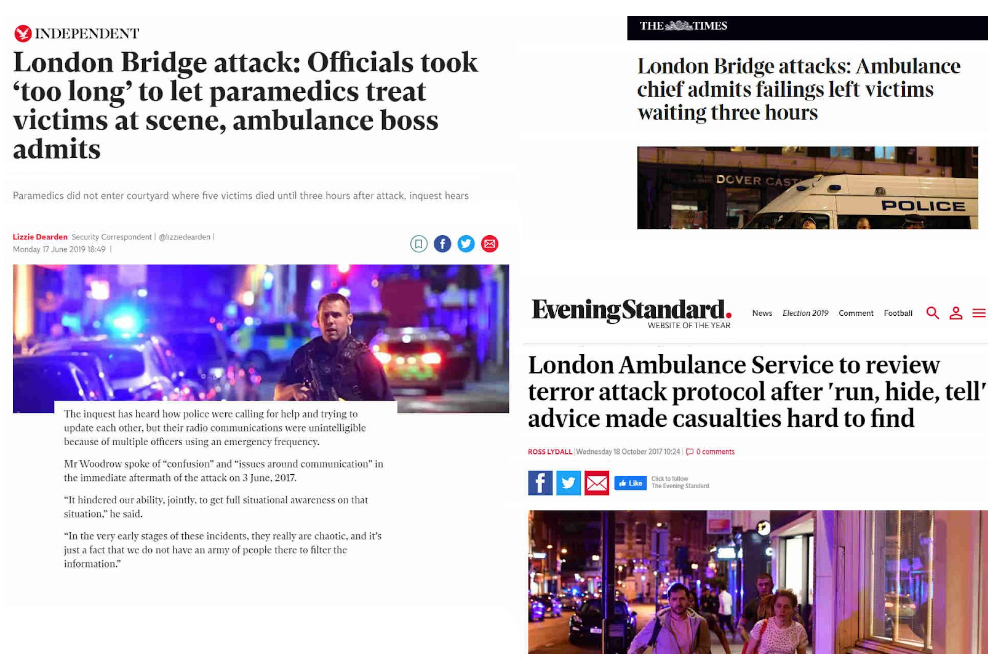When It All Goes Wrong: Part 4: London Terror Attacks

- Introduction
- Part 1: Grenfell
- Part 2: Crossrail
- Part 3: HS2
- Part 4: London Terror Attacks
- Part 5: Boeing 737
In this series, we are looking at a range of situations where the symptoms of Complexity – and of inappropriate responses to Complexity – are particularly striking.
Whilst most Complexity-driven situations (and most of the inappropriate responses made) will never escalate this far, you may well recognise many elements of your own situation in these examples.
Part 4: London Terror Attacks

On 3rd June 2017, a van was deliberately driven into pedestrians on London Bridge.
Immediately afterwards, its three occupants – Islamic State sympathisers and supporters – attacked people with knives in nearby Borough Market.
In total, eight people were killed and 48 were injured, with the incident being headline news around the world.
An “Expected” Calamity…
A similar attack had taken place on Westminster Bridge in March 2017 and the UK’s terror threat had been set to either “severe” or “critical” in the immediate weeks prior to the London Bridge attack, so incidents were expected.
However, as with any Complex situation, the specific event and how it unfolded were both unforeseen and surprising – things escalated rapidly and unpredictably – and the spotlight in the aftermath eventually widened to examine the responses made.
Even though the three perpetrators were shot dead within eight minutes of the initial call – and notwithstanding their culpability and the astonishing bravery of the emergency services – questions were asked about how the situation and how it had been handled.
And, as is so often the case with Complexity, some things were found wanting.
…But an Inadequate Response
An 18th June 2019 article in the Health Service Journal (HSJ) highlighted several issues.
Typical of a Complex situation, there was a large amount of confused and confusing information to try and make sense of.
This was not helped by the fact that, even with a high state of alert, there were insufficient resources available.
However, perhaps most concerning of all – especially given the obvious Complexity, both in general with such situations and in this case, particularly – was the insistence on following predetermined protocols:
“The inquest heard at least two London Ambulance Service paramedics knew there were wounded people in the courtyard and one shouted down to police officers and members of the public trying to keep the wounded alive that paramedics would be with them soon. But before the medical staff could be dispatched, emergency service commanders at the scene activated specific protocols to deal with a “marauding terrorist” attack as underway, called Operation Plato.”
In other words, the London Ambulance Service had already decided in advance how a response should be made.
In Conclusion: Doubling-Down
Despite the “prefabricated” response being a significant factor in preventing paramedics reaching critically injured people, the Operational Director defended the approach taken.
“[Paul] Woodrow denied this was a failure of policy, saying the service was responding to a “very dynamic” situation. “I’ve not experienced an incident of this magnitude and dynamic nature,” he said. “But my experience of the management of major incidents is it does take time for command structures to be put in place.”
In the same breath as acknowledging the uniqueness of the situation, then, he therefore defended standard approaches.
Of course, a desire to deflect criticism is understandable – the ambulance service were hardly “culprits” and rushed into the face of danger – but a “command structure” only makes sense when most or all variables are known and predictable.
We also saw that thankfully – and reflecting that decisions in a Complex environment are nearly always best taken by those directly involved – some paramedics defied policy.
But until Complexity-appropriate approaches are encouraged – rather than only possible in defiance of authority – outrages like the London Bridge attack will only potentially be made worse.

